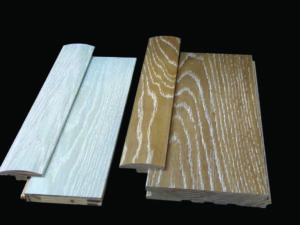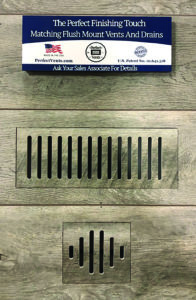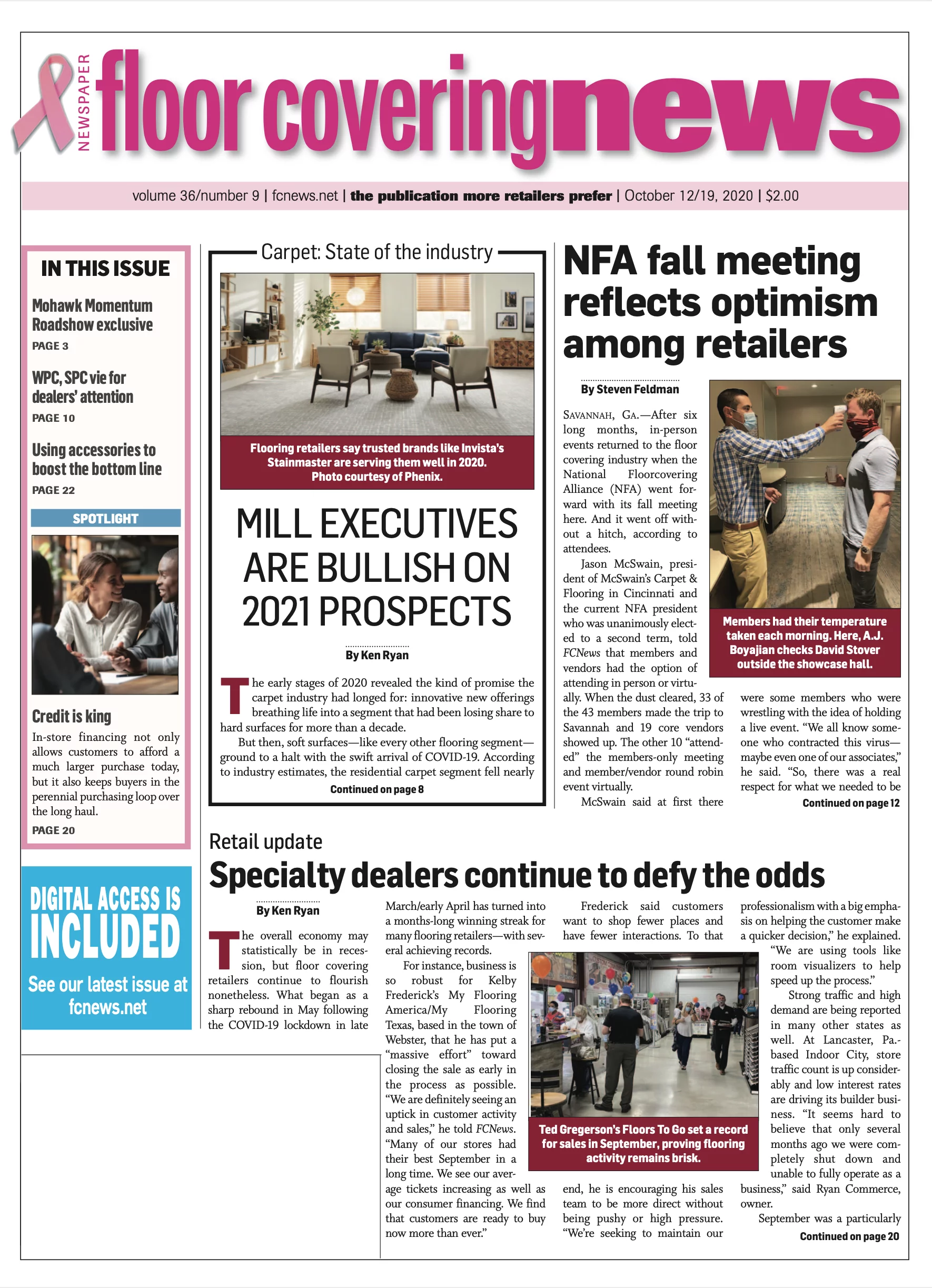By Megan Salzano

Flooring accessory products—trim, moldings, vents, stair treads—are the backbone of any successful flooring installation. As any good flooring installer or contractor will tell you, the accessories complete the job—and without them an installation is likely to produce unhappy results. But beyond the benefits to the consumer, accessory products offer a host of benefits to the dealer.
Today’s retailers are competing with the speed and flexibility of their digital counterparts. As such, a one-stop shopping experience—combined with unmatched customer service—is essential for a brick-and-mortar operation to succeed. The case is no different when it comes to flooring retail, and stocking accessories helps supply that experience.
“Customers are project buyers,” explained Haley Plank, marketing manager, Flexco Floors. “They like the convenience of shopping in one place and acquiring all the items they need to complete a project. Including [accessories] as part of your product portfolio increases customer satisfaction because they can purchase multiple products for their project in one place.”
Mark Pacacha, national sales manager, Seneca Millwork, agreed, adding, “It benefits the customer when the proper pro- file type, size, matching stain and finish are readily sourced for her, eliminating the need to figure this out on her own or find another supplier.”
More to the point of profit, according to suppliers, accessories provide higher margins than many other product categories and should be treated as such. “Moldings are usually the higher-margin items on the ticket, which adds to the net growth profit of the sale for the retailer,” explained Kraig Coxon, president, Pennwood Products. “Manufacturers, wholesalers and retailers when providing the floor should look at moldings as the ‘easy add-on’ when presented properly. All channels today are looking to enhance their bottom line—and trim and molding should be one of them.”

Joe Kennedy, president, Perfect Vents, agreed, noting that accessories should be considered part of the initial, overall flooring purchase. “Most accessories, like our vents, are best sold as part of the initial sale rather than an extra charge. If presented during the initial sale—and the benefits are properly laid out—the customer is much more likely to move forward with the purchase. If a store does not have a good checklist to go through while measuring or completing a job, many things will get overlooked, and it becomes an extra expense and hassle to go back and complete the job at a later date.”
Accessory suppliers also stressed the importance of preemptively asserting the need for accessories rather than waiting for the consumer to broach the subject. “Just because a customer might not ask for something does not mean they don’t want it or need it,” Kennedy explained. “It could mean they don’t know it’s an option.”
A good salesperson, Kennedy added, will educate and guide the customer through the process and then let the customer make the final decision. “If a salesperson goes into a sale thinking the customer won’t spend the extra money, that will most likely be the outcome,” he explained. “If a salesperson goes into a sale with an open mind and shows the customer the options that would make the job turn out the best, not only will the customer be happier, but the store will also add to their bottom line.”
Not only do accessories provide high profit margins and help a retailer offer that one-stop-shopping experience, they also help provide a point of differentiation from other competitors. “These vents are not something a customer is going to see in the box stores, so it can give retailers a competitive advantage,” Kennedy said. “This is also a category that most home stores are not even offering as an option right now, so it’s an easy way to add some additional profit to a job.”
Overcoming obstacles
There are several challenges retailers often come up against when it comes to accessory products, and suppliers agree these challenges have stifled growth opportunities.
The issue of when exactly to bring up accessory products during the purchase experience has lingered for years, and suppliers remain adamant that the retailer should move away from the typical “add-on” mentality and more toward selling the “complete package—accessories included.”
But other challenges still remain. For example, some suppliers agree retailers get caught up on the logistics of the sale. “It used to be said that all your accessories should be about 10% of the total cost of the job,” explained Bill Treiber, technical sales and education manager, Artistic Finishes. “Be careful stating this today. Your customer will dictate that amount by the questions you ask and what the jobsite requires.”
This brings up another challenge—qualifying the customer’s needs. This step in the process is not limited to the flooring itself but includes the accessory products as well. Suppliers agree, retailers would do well to delve deeper. “The first step is to better understand what the customer wants and needs,” Flexco’s Plank said. “Some questioning about why they are in the retail outlet are helpful. Some questions about what they are shopping for or what type of project they are trying to complete might provide some insight into the scope of products they want to buy. And, questions about where else they might be shopping for this project would help retailers better understand what complementary products they might stock.”
When looking to properly qualify the customer, retailers and their RSAs must be up to speed on their own offerings and the proper function of each. This, suppliers agree, is another challenge that typically plagues the industry, but can be overcome with some in-store education.
“The old saying ‘knowledge is power’ certainly holds true here,” Artistic Finishes’ Treiber said. “The reason some retailers struggle with this category is because they choose not to make it an important part of their success. Proper job estimating, asking questions and explaining the required accessories need to be a viable part of the training and educating of one’s employees for all to be confident and comfortable with the recommendations that materialize for each job’s needs.”
Become a learner of the trade, he added. “Be open to new ideas and products. Commit to learning what the industry has to offer, because it is changing every day. Listen to what your customer is telling you they want or don’t want. And finally, become equipped.”
Merchandising matters
Becoming equipped with product knowledge is one step on the road to success with accessories. The next step is becoming physically equipped with the proper merchandizing. But, how can a retailer know what products are right for them? For Flexco’s Plank, it’s all about options. “Retailers who carry a line of [accessories]—a good, better, best assortment—increase the likelihood that their customers will purchase something more than the simplest design,” she explained. “A tiered-price offering says to the customer, ‘You have choices’ and the freedom to express themselves while giving the retailer the chance to increase their average ticket price for each transaction.”
To avoid overwhelming the consumer, Plank noted the importance of strategic marketing. “We have found that showing customers examples of finished projects, no matter what or where they have been completed, helps them visualize how their project would come to life,” she said. “It shows them the variety of different products they should consider and gives them confidence that they can select the right product for their home or commercial space.”
For Pennwood’s Coxon, every retailer should have a molding board showing the various profiles and demonstrating, if possible, the application. “This is the time to explain that the molding is designed to ‘blend’ and complement the floor. The consumer will appreciate that the salesperson has taken the time to explain all aspects of the installation and will set them apart from the competition.”
When it comes to choosing a particular product, he further explained that, today, the universal “go-to” product is white painted and primed quarter round and shoe molding, which might be a retailer’s best bet. “White painted and primed moldings are used across many of today’s product categories such as ceramic, LVT, vinyl and hardwood. This offers the retailer a high-margin item with a high-turn ratio.”
When it comes to wood accessories, Seneca’s Pacacha said one should ‘job pack’ each job. “With the hundreds of wood samples in a showroom there is no need to guess which colors to stock. If a store has a builder account that has three to five SKU/color selections, then stock coordinating moldings the builder uses for their homes.”
Like most suppliers in the category, Perfect Vents’ Kennedy agreed samples in the showroom is a must, as is in-store education—not only for the benefit of the consumer, but for the sale as well. “Trying to describe a trim or a vent without a physical sample is extremely difficult for a customer that has limited experience in flooring. On that same note, making sure the sales staff is educated on all the options available is just as important. The retailer could have the best options available, but if the sales staff is in the dark it doesn’t do any good.”

